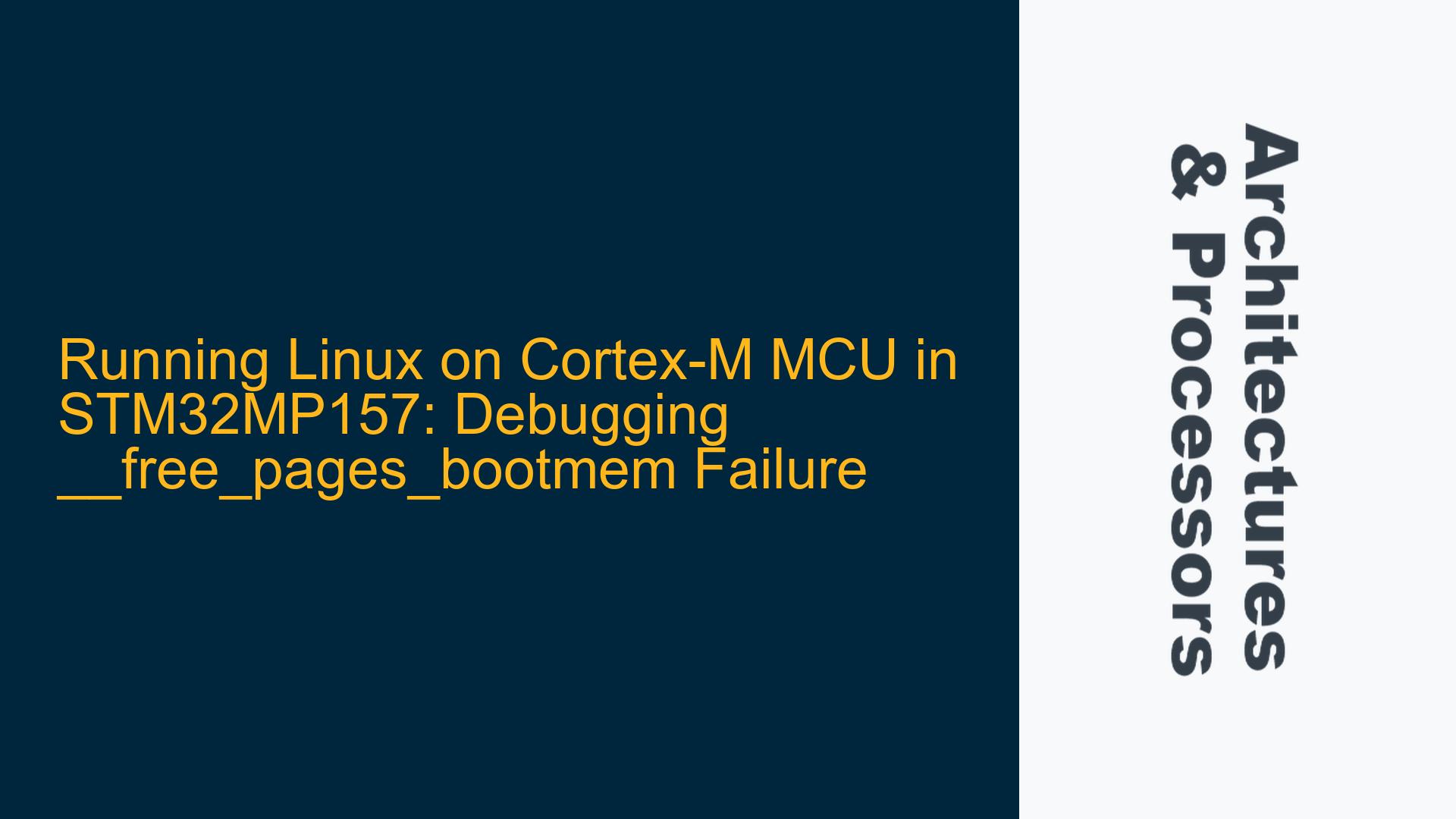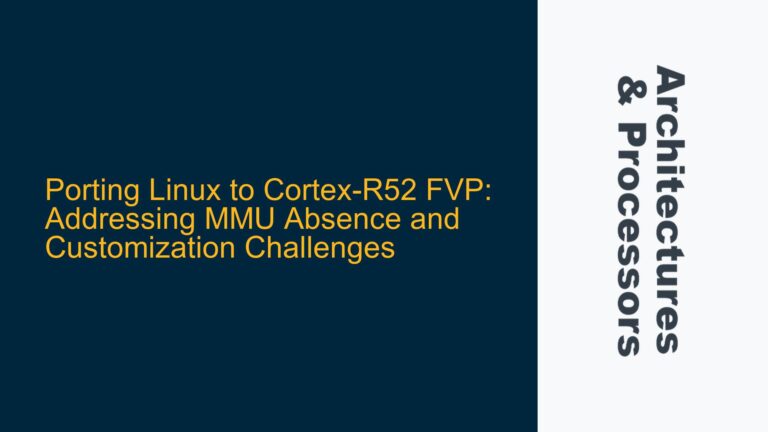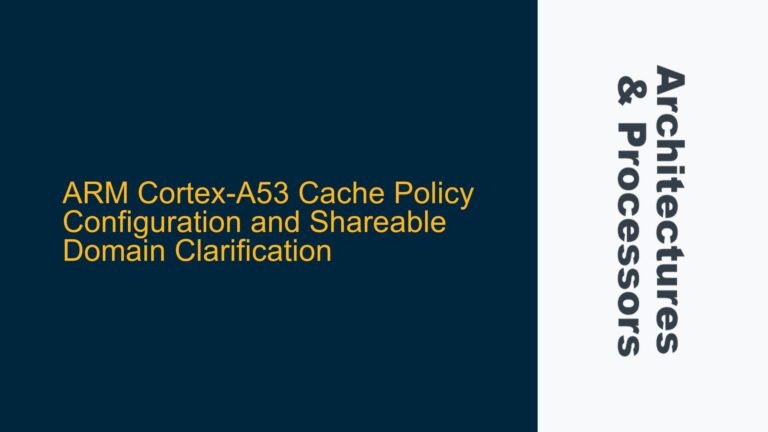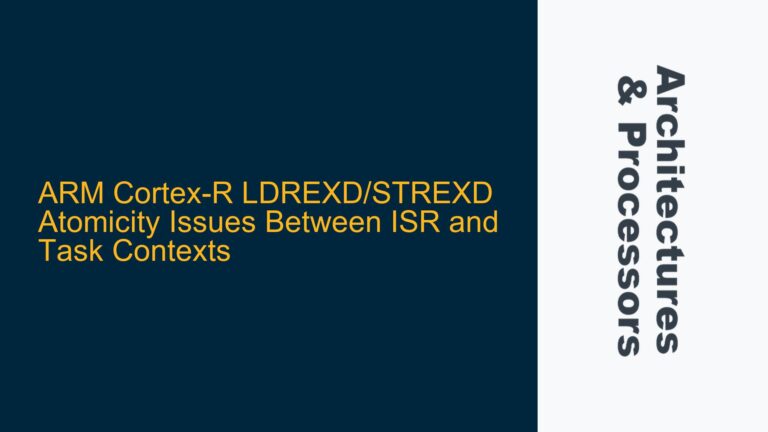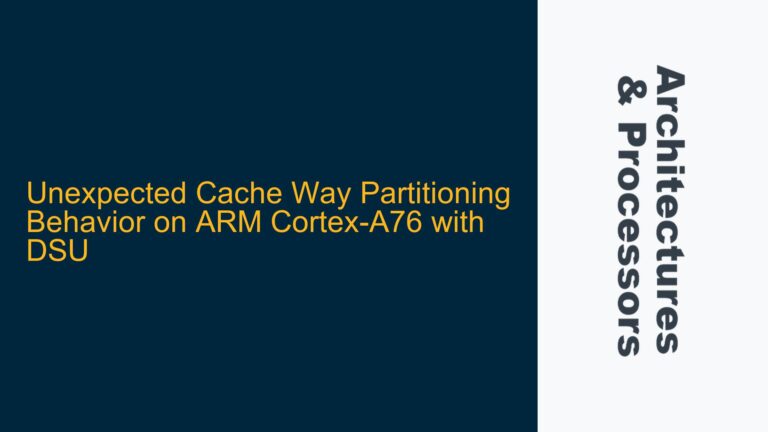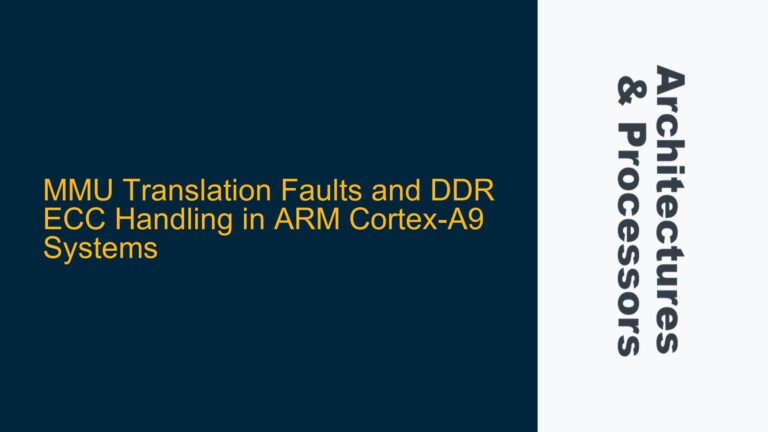ARM Cortex-M Linux Kernel Boot Failure in STM32MP157
The core issue revolves around attempting to run a Linux kernel on a Cortex-M microcontroller within the STM32MP157 evaluation board, specifically encountering a failure in the __free_pages_bootmem function during kernel initialization. This function is part of the Linux kernel’s memory management subsystem, responsible for freeing pages allocated during the boot process. The failure suggests a fundamental incompatibility or misconfiguration in the system setup, particularly when comparing the behavior between the STM32F429 (Cortex-M4) and the STM32MP157 (Cortex-M core).
The STM32MP157 is a dual-core processor featuring both Cortex-A and Cortex-M cores. While the Cortex-A core is designed for running full-fledged operating systems like Linux, the Cortex-M core is typically used for real-time tasks and is not natively supported by the Linux kernel. This discrepancy is a critical factor in the observed failure. The user’s assumption that the Cortex-M4 and STM32MP157 Cortex-M cores are identical is incorrect, as the STM32MP157’s Cortex-M core is not intended for running Linux. This misunderstanding likely led to the attempt to port Linux to an unsupported architecture, resulting in the __free_pages_bootmem failure.
The error manifests during the kernel’s boot process, specifically when the memory management subsystem attempts to free pages allocated during bootstrapping. This indicates that the kernel is unable to properly manage memory on the Cortex-M core, likely due to architectural differences or missing hardware features required by the Linux kernel. The Cortex-M core lacks a Memory Management Unit (MMU), which is essential for Linux’s virtual memory management. Without an MMU, the kernel cannot perform address translation, memory protection, or other critical operations, leading to failures in functions like __free_pages_bootmem.
Cortex-M Core Limitations and Linux Kernel Requirements
The primary cause of the failure is the architectural mismatch between the Cortex-M core and the Linux kernel’s requirements. The Cortex-M core in the STM32MP157 is designed for real-time, low-power applications and does not include an MMU, which is a fundamental requirement for running Linux. The Linux kernel relies on the MMU for virtual memory management, process isolation, and memory protection. Without an MMU, the kernel cannot properly manage memory, leading to failures in functions like __free_pages_bootmem.
Another contributing factor is the difference in memory management between the Cortex-M4 and the Cortex-M core in the STM32MP157. While both cores are based on the ARMv7-M architecture, the STM32MP157’s Cortex-M core is optimized for different use cases and may have different memory configurations or limitations. The user’s assumption that the memory management setup for the STM32F429 (Cortex-M4) would work on the STM32MP157’s Cortex-M core is incorrect, as the memory map, peripheral addresses, and other hardware-specific details are likely different.
Additionally, the Linux kernel’s memory management subsystem is highly optimized for architectures with an MMU, and it assumes the presence of certain hardware features that are not available on the Cortex-M core. For example, the kernel expects the ability to perform virtual-to-physical address translation, which is not possible without an MMU. This mismatch between the kernel’s expectations and the hardware’s capabilities leads to failures in memory management functions like __free_pages_bootmem.
Addressing Cortex-M Linux Kernel Boot Failures
To resolve the issue, the first step is to recognize that the Cortex-M core in the STM32MP157 is not suitable for running a standard Linux kernel. Instead, consider using a real-time operating system (RTOS) or a lightweight Linux variant like µClinux, which is designed for MMU-less processors. µClinux is a modified version of the Linux kernel that can run on microcontrollers without an MMU, making it a better fit for the Cortex-M core.
If running Linux on the Cortex-M core is a strict requirement, the next step is to modify the kernel to work without an MMU. This involves significant changes to the memory management subsystem, including rewriting functions like __free_pages_bootmem to work with physical memory addresses directly. This approach is highly complex and requires deep expertise in both the Linux kernel and the ARM architecture. It is not recommended for most users, as it involves substantial development effort and may result in an unstable system.
Another approach is to leverage the Cortex-A core in the STM32MP157 for running Linux, while using the Cortex-M core for real-time tasks. This setup allows you to take advantage of the Cortex-A core’s MMU and other features required by Linux, while still benefiting from the Cortex-M core’s real-time capabilities. STMicroelectronics provides a Linux distribution for the STM32MP157 that is optimized for the Cortex-A core, making it easier to get started with Linux on this platform.
In summary, the failure in __free_pages_bootmem is a direct result of attempting to run a standard Linux kernel on a Cortex-M core that lacks an MMU. The most practical solution is to use an RTOS or µClinux for the Cortex-M core, or to run Linux on the Cortex-A core while using the Cortex-M core for real-time tasks. Modifying the Linux kernel to work without an MMU is possible but requires significant expertise and effort, making it a less viable option for most users.
Detailed Analysis of Cortex-M Core Limitations
The Cortex-M core in the STM32MP157 is based on the ARMv7-M architecture, which is optimized for real-time, low-power applications. Unlike the Cortex-A core, which is designed for running full-fledged operating systems like Linux, the Cortex-M core lacks several features that are essential for Linux’s operation. One of the most critical missing features is the Memory Management Unit (MMU). The MMU is responsible for virtual memory management, which allows the operating system to create isolated address spaces for different processes, manage memory protection, and perform address translation.
Without an MMU, the Linux kernel cannot perform these essential functions, leading to failures in memory management operations. The __free_pages_bootmem function, for example, relies on the kernel’s ability to manage virtual memory, which is not possible on the Cortex-M core. This function is part of the kernel’s boot memory allocator, which is responsible for freeing pages that were allocated during the boot process. When the kernel attempts to free these pages, it encounters an error because it cannot properly manage memory without an MMU.
In addition to the lack of an MMU, the Cortex-M core has other limitations that make it unsuitable for running a standard Linux kernel. For example, the Cortex-M core has a simpler interrupt handling mechanism compared to the Cortex-A core, which can lead to issues when running a complex operating system like Linux. The Cortex-M core also has a different memory map and peripheral configuration, which can cause compatibility issues when porting software from other platforms.
Exploring µClinux as an Alternative
Given the limitations of the Cortex-M core, one viable alternative is to use µClinux, a variant of the Linux kernel that is designed to run on microcontrollers without an MMU. µClinux modifies the Linux kernel to work with physical memory addresses directly, eliminating the need for virtual memory management. This makes it possible to run a Linux-like operating system on the Cortex-M core, albeit with some limitations.
µClinux is not a full-fledged Linux distribution, and it lacks some of the features and capabilities of a standard Linux kernel. For example, µClinux does not support process isolation or memory protection, which can make it less secure and more prone to crashes. However, for many embedded applications, these limitations are acceptable, and µClinux provides a good balance between functionality and resource requirements.
To use µClinux on the STM32MP157’s Cortex-M core, you will need to download and configure the µClinux kernel for your specific hardware. This involves setting up a cross-compilation environment, configuring the kernel for the STM32MP157, and building the kernel image. Once the kernel is built, you can load it onto the Cortex-M core and begin developing your application.
Leveraging the Cortex-A Core for Linux
Another approach is to use the Cortex-A core in the STM32MP157 for running Linux, while using the Cortex-M core for real-time tasks. This setup allows you to take advantage of the Cortex-A core’s MMU and other features required by Linux, while still benefiting from the Cortex-M core’s real-time capabilities. STMicroelectronics provides a Linux distribution for the STM32MP157 that is optimized for the Cortex-A core, making it easier to get started with Linux on this platform.
To use the Cortex-A core for Linux, you will need to configure the STM32MP157 to boot from the Cortex-A core and load the Linux kernel. This typically involves setting up a bootloader, such as U-Boot, to load the kernel image and device tree blob (DTB) into memory. Once the kernel is loaded, you can use the Cortex-M core for real-time tasks, such as controlling peripherals or handling interrupts.
This approach provides the best of both worlds, allowing you to run a full-fledged Linux operating system on the Cortex-A core while using the Cortex-M core for tasks that require real-time performance. It also avoids the need to modify the Linux kernel to work without an MMU, which can be a complex and error-prone process.
Conclusion
The failure in __free_pages_bootmem when attempting to run Linux on the Cortex-M core of the STM32MP157 is a direct result of the core’s lack of an MMU and other features required by the Linux kernel. The most practical solution is to use an RTOS or µClinux for the Cortex-M core, or to run Linux on the Cortex-A core while using the Cortex-M core for real-time tasks. Modifying the Linux kernel to work without an MMU is possible but requires significant expertise and effort, making it a less viable option for most users.
By understanding the limitations of the Cortex-M core and choosing the appropriate operating system for your application, you can avoid the pitfalls of trying to run a standard Linux kernel on an unsupported architecture. Whether you choose to use µClinux, an RTOS, or a combination of Linux on the Cortex-A core and real-time tasks on the Cortex-M core, the key is to match the operating system to the hardware’s capabilities and your application’s requirements.
